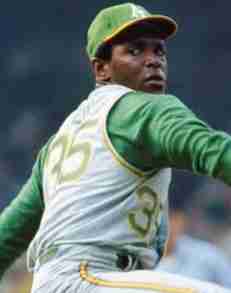VIDA BLUE: "There are few players with a more decorated career than Vida Blue," the Oakland Athletics said in a statement. "Vida will always be a franchise legend and a friend." PHOTO COURTESY OF REDLEGNATION
Vida Blue, a hard-throwing left-hander who became one of baseball’s biggest draws in the early 1970s and helped lead the brash Oakland Athletics to three straight World Series titles before his career was derailed by drug problems, died Saturday, according to the team. He was 73.
Blue died at a hospital in San Francisco’s East Bay area of medical complications stemming from cancer, the Athletics said. Blue had used a walking stick to assist his movement at a 50th anniversary of the 1973 A’s championship team on April 16.
"He was engaging. He was personable. He was caring," ex-teammate Reggie Jackson said during an interview with The Associated Press on Sunday. "He was uncomfortable with the crowd."
Blue was voted the 1971 American League Cy Young Award and Most Valuable Player after going 24-8 with a 1.82 ERA and 301 strikeouts with 24 complete games, eight of them shutouts. He was 22 at when he won MVP, the youngest to win the award. He remains among just 11 pitchers to win MVP and Cy Young in the same year.
Blue finished 209-161 with a 3.27 ERA, 2,175 strikeouts, 143 complete games and 37 shutouts over 17 seasons with Oakland (1969-77), San Francisco (1978-81, 85- 86) and Kansas City (1982-83). He appeared on the Hall of Fame ballot four times, receiving his most support at 8.7% in 1993, far short of the 75% needed.
"That Hall of Fame thing, that’s something that I can honestly, openly say I wish I was a Hall of Famer," Blue told The Washington Post in 2021. ”And I know for a fact this drug thing impeded my road to the Hall of Fame – so far."
A six-time All-Star and three-time 20game winner, Blue helped pitch the Swingin’ A’s, as Charley Finley’s colorful, mustachioed team was known, to consecutive World Series titles from 1972-74. Since then, only the 1998-2000 New York Yankees have accomplished the feat.
He became the first pitcher to start the All-Star Game for both leagues, opening for the AL in 1971 and ’75 and the NL in ’78.
"I remember watching a 19-year-old phenom dominate baseball, and at the same time alter my life," Dave Stewart, a four-time 20-game winner for the A’s a generation later, wrote on Twitter. "There are no words for what you have meant to me and so many others."
Jackson was shocked by how much weight Blue had lost when he saw him at the 50th reunion.
"I did not recognize him," Jackson said. "I was shattered. I was shaken. That will stick with me the rest of my life."
Selected by the then Kansas City Athletics on the second round of the 1967 amateur draft, Blue made his big league debut with Oakland on July 20, 1969, about a week shy of his 20th birthday. He made four starts and 12 relief appearances, then spent most of 1970 at Triple-A Iowa.
Called up when rosters expanded, he pitched a one-hit shutout at Kansas City in his second start. In his fourth start, Blue pitched a no-hitter against Minnesota on Sept. 21, at 21 years, 55 days that made him the youngest pitcher to throw a no-hitter since the live ball era started in 1920.











No Comment